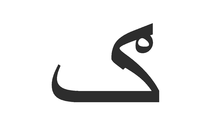Gaf


| Persian alphabet |
|---|
|
ا ب پ ت ث ج چ ح خ د ذ ر ز ژ س ش ص ض ط ظ ع غ ف ق ک گ ل م ن و ه ی |
|
Perso-Arabic script |
| Arabic alphabet |
|---|
|
Arabic script |
Gaf, or gāf, may be the name of different Perso-Arabic letters, all representing /ɡ/. They are all forms of the letter kāf, with additional diacritics, such as dots and lines. There are four forms, each used in different places:
- گ in Perso-Arabic and sometimes in Moroccan, occidental Algerian and many Berber languages
- ݢ in Jawi
- ݣ in Moroccan, occidental Algerian and many Berber languages
- ګ in Pashto
- ڳ in Saraiki
For speakers with /ɡ/ as the main phoneme for ق, the name can be used for the letter when trying to explain a pronunciation/spelling of a word, whether the word is foreign or dialectal.
Gaf with line
گ is based on kāf with an additional line. It is rarely used in Arabic itself, but may be used to represent the sound /ɡ/ when writing other languages. It is frequently used in Persian, Pashto, Uyghur, Urdu and Kurdish and is one of four Perso-Arabic letters not found in Arabic.
ݣ can also be used to represent /ɡ/ in Morocco, occidental Algeria and many Berber languages.
| Position in word: | Isolated | Final | Medial | Initial |
|---|---|---|---|---|
| Glyph form: | گ | ـگ | ـگـ | گـ |
Gaf with single dot
ݢ is derived from a variant form (ک) of kāf with the addition of a dot. It is not used in the Arabic language itself, but is used in the Jawi script of Malay to represent a voiced velar stop /ɡ/. Unicode includes two forms on this letter: one based on the standard Arabic kāf, ك, and one based on the variant form ک. The latter is the preferred form.[1]
| Appearance | Code point | Name |
|---|---|---|
| ڬ | U+06AC | ARABIC LETTER KAF WITH DOT ABOVE |
| ݢ | U+0762 | ARABIC LETTER KEHEH WITH DOT ABOVE |
| Position in word: | Isolated | Final | Medial | Initial |
|---|---|---|---|---|
| Glyph form: | ڬ | ـڬ | ـڬـ | ڬـ |
| Position in word: | Isolated | Final | Medial | Initial |
|---|---|---|---|---|
| Glyph form: | ݢ | ـݢ | ـݢـ | ݢـ |
Gaf with line and two dots
ڳ is derived from a variant form (ک) of kāf with the addition of a line and two dots. It is used not in Arabic alphabet itself but in the Saraiki alphabet.
| Position in word: | Isolated | Final | Medial | Initial |
|---|---|---|---|---|
| Glyph form: | ڳ | ـڳ | ـڳـ | ڳـ |
Gaf with three dots
.png)
ݣ is based on a variant form (ک) of kāf with the addition of three dots. It is used in western Algerian Arabic (elsewhere in Algeria, ڨ is used), in Moroccan Arabic (though Persian گ can also be used) and in many Berber languages to represent /ɡ/. Examples of its use include city names (such as Agadir أݣادير, also written: أغادير) and family names (such as El Guerrouj الݣروج, also written: الكروج). In Morocco, western Algeria, and many Berber languages, the Persian letter گ can also be used instead.
| Position in word: | Isolated | Final | Medial | Initial |
|---|---|---|---|---|
| Glyph form: | ݣ | ـݣ | ـݣـ | ݣـ |
Its initial and medial forms are identical to ڭ, which represents /ŋ/ in some languages. However, their isolated and final forms are different.
Gaf with ring
In Pashto:
| Position in word: | Isolated | Final | Medial | Initial |
|---|---|---|---|---|
| Glyph form: | ګ | ـګ | ـګـ | ګـ |
Gaf with inverted stroke
In Chechen on the Arabic character ࢰ is used to write a Кӏ (Kh).
| Position in word: | Isolated | Final | Medial | Initial |
|---|---|---|---|---|
| Glyph form: | ࢰ | ـࢰ | ـࢰـ | ࢰـ |
Character encoding
| Character | گ | ڳ | ݢ | ڴ | ڰ | ࢰ | ||||||
|---|---|---|---|---|---|---|---|---|---|---|---|---|
| Unicode name | ARABIC LETTER GAF | ARABIC LETTER GUEH | ARABIC LETTER KEHEH WITH DOT ABOVE | ARABIC LETTER GAF WITH THREE DOTS ABOVE | ARABIC LETTER GAF WITH RING | ARABIC LETTER GAF WITH INVERTED STROKE | ||||||
| Encodings | decimal | hex | decimal | hex | decimal | hex | decimal | hex | decimal | hex | decimal | hex |
| Unicode | 1711 | U+06AF | 1715 | U+06B3 | 1890 | U+0762 | 1716 | U+06B4 | 1712 | U+06B0 | 2224 | U+08B0 |
| UTF-8 | 218 175 | DA AF | 218 179 | DA B3 | 221 162 | DD A2 | 218 180 | DA B4 | 218 176 | DA B0 | 224 162 176 | E0 A2 B0 |
| Numeric character reference | گ | گ | ڳ | ڳ | ݢ | ݢ | ڴ | ڴ | ڰ | ڰ | ࢰ | ࢰ |
See also
References
- ↑ Jonatha Kew (2003). "Proposal to encode Jawi and Moroccan Arabic GAF characters" (PDF).